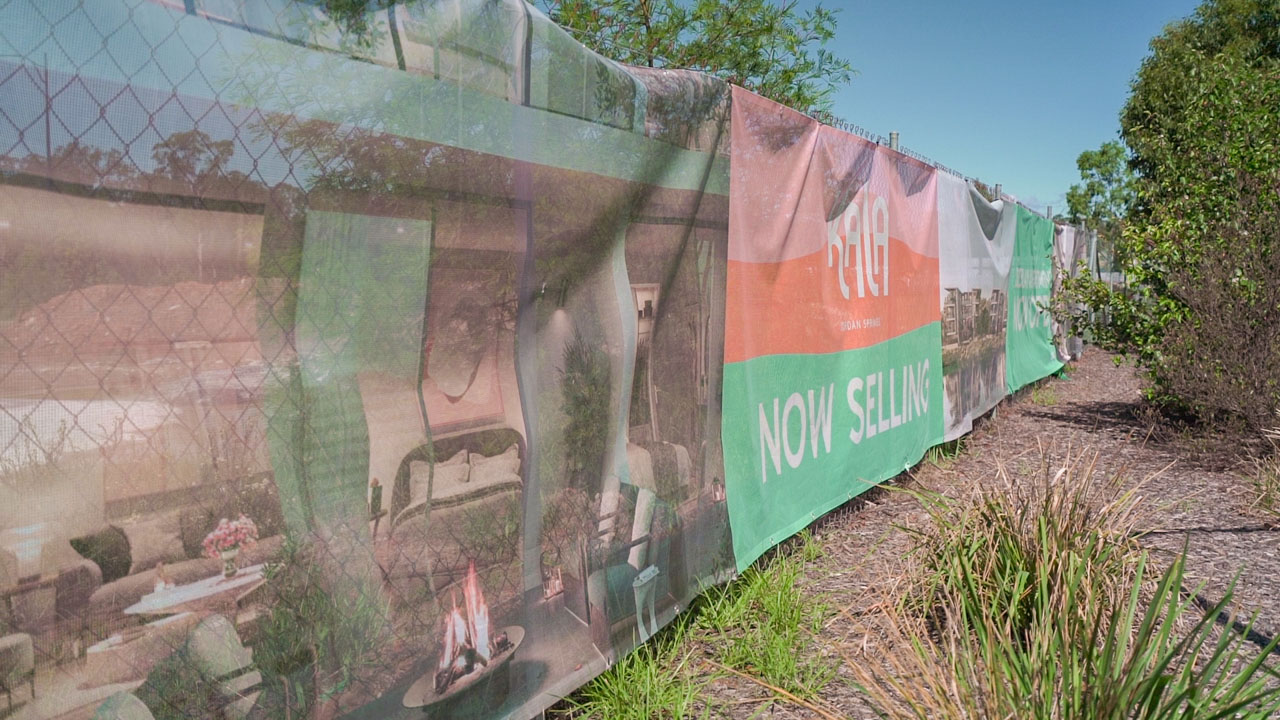The ultimate guide to banner mesh

Banner mesh is commonly seen covering temporary fencing around construction sites, advertising new housing estates, adorning fences at events and along civil construction areas such as road and rail corridors.
As the name implies, it is a banner or large format sign created from polyester woven mesh fabric. Similar to printed shade cloth (although not quite the same), the flat woven construction of the mesh allows for high impact digital printing whilst also allowing air to flow through it.
As one of the experts in high volume banner mesh production, we get a lot of questions, so we’ve put together the ultimate guide to banner mesh!
Wait – are we talking about the same product?
When it comes to banner mesh there are loads of different names for what is basically the same product. Here’s some of the ones we’ve come across.
So, if you’ve landed here after a google search of one of these terms then rest assured - we’re talking about the same thing!
|
Branding wrap Building wraps Construction banners Construction mesh Construction site fencing fabric Event mesh Fence mesh Fence signage Fence wrap
|
Hoarding mesh wrap Large format printed mesh Mesh banner rolls Outdoor mesh banners Outdoor printed mesh Premium banner mesh Printed fence fabric Printed fence mesh Printed fence screens
|
Printed fence wraps Printed scrim Printed shade cloth Printed sign mesh Site banners Site hoarding wraps Site wrap Sports mesh Temp fence banners
|
As you can see, this is a very long list! From here on in we’ll refer to it as banner mesh for simplicity.
So, are banner mesh and printed shade cloth the same thing?
Not quite: even though many people refer to banner mesh as printed shade cloth, banner mesh is actually a bit different to that coarse scratchy green stuff covering your neighbours greenhouse.
Whilst shade cloth is a coarsely woven, rough material, banner mesh is a more refined version. It is smoother, enabling better print quality, and in most cases it differs in the way it is made. Banner mesh is made from extruded polyester, whereas shadecloth is usually made from quite loosely woven polyester. It’s the weaving that makes shade cloth rough, compared to the smooth extruded finish of banner mesh.
What is banner mesh used for?
Printed banner mesh is usually used for 3 main reasons: as a privacy or anti-gawking screen, to limit the amount of dust and debris being emitted from a work site, and to advertise a project, event or brand.
Many workplace safety authorities require contractors to control dust and debris on site, and banner mesh is a cheap and effective way to meet these requirements.
It is also an important safety measure on some projects: banner mesh prevents the public from being distracted by the activities on worksites. This is particularly important where construction is happening along freeways and there is a risk that something could catch a motorist’s attention, and consequently cause an accident.
Mesh also provides some privacy and security, screening off expensive equipment and small items on site that could be subject to theft.
And of course, the ability to print striking full colour graphics on banner mesh means you’ve got a huge ready-made canvas to advertise your project.
Why are there different types of banner mesh?
Mesh banners come in a variety of different fabric weights for different purposes. The most commonly seen fabrics are a close knit or premium mesh that offers high privacy, and an open weave mesh that is more see through. Airflow is the biggest difference between banner materials and will probably be the deciding factor when you buy banner mesh.
Closed or premium weave mesh provides better print quality, but can restrict airflow. Open weave mesh provides almost the same print quality but allows more wind passage. Therefore, open weave banner mesh can be a better choice for exposed or coastal areas.
Premium or closed weave banner mesh is made from 80% material with 20% air breathability, with a fabric weight of 280 gsm.
Open weave banner mesh has 50% material with 50% air breathability, and a fabric weight of 175 gsm.
Both are made from strong UV treated polyester, making them both tough and easy to handle.
How long is a roll of banner mesh?
We receive our plain white banner mesh in 50 metre rolls, however we can cut these down to any length you need - there’s no minimum order quantity.
Both open weave and premium mesh are available in two widths – 1.6 metres or 1.8 metres.
The shorter 1.6 m version is ideal if you need to apply the finished product to a fence that has a solid bottom, such as a concrete barrier with an anti-gawking steel mesh screen on top. The 1.6m mesh covers the wire mesh but not the barrier, ensuring the concrete can be seen for safety.
The more popular 1.8m wide rolls neatly cover full metal mesh fences such as temporary site fencing, cyclone fencing, chain wire fences and permanent security fencing seen around the perimeter factories.
Does wind catch the mesh and cause problems?
Generally no, if you’ve got a few other things in order. Making sure your fence is securely installed and braced will offer a stable base to support the mesh moving in gentle winds.
However, installing a tightly woven mesh in a windy environment can cause it to act like a sail, adding strain on the banner. The added pressure will increase the chance of rips, tears, and pulling around the eyelets. For this reason open weave mesh is recommended for high wind areas or for exposed coastal projects. Wind slits can also be added during the manufacturing process if you have a highly wind affected site.
How do I attach banner mesh to my fence?
Banner mesh is supplied with different fixing options although the most common request is to have the mesh fitted with eyelets, so that it can be easily cable tied to a fence.
The eyelets are placed every metre along the top edge, punched into a reinforced seam. This creates a strong support base.
It’s easy to hang banner mesh by yourself, although it’s quicker with a friend. We suggest you keep your mesh rolled up and unroll it as you go along the fence, looping a cable tie through the eyelet and through an opening in the metal mesh of the fence.
So I can just hang banner mesh on my temporary fencing?
Yes, but there’s just one more thing you might need to consider. If your temporary fence doesn’t have any bracing or support struts – small angled pieces that sit perpendicular to the fence line – you may need to add some.
The cumulative weight of many metres of mesh will add pressure to your fence and cause it to become slightly less stable in the event of wind, storms or light impacts. Therefore, it’s best to include support braces in your temporary fencing to ensure the fence can adequately support the additional weight of the fabric. Read more about bracing in our temporary fence bracing article.
Permanent chain link fence or cyclone fencing is normally strong enough to support banner mesh. Likewise, many customers have used our banner mesh on the aluminium security fence surrounding their office or factory.
What’s the best type of banner mesh for high quality printing?
Premium banner mesh gives very high print quality. 80% of its surface is printable and therefore the image translates with excellent quality onto the mesh substrate. Open weave mesh offers a slightly reduced quality with only 50% surface area to print on, however the overall effect especially with bold block designs and colours is often just as good as premium mesh. Your particular design or logo might lend itself to a certain type of mesh – feel free to send your image through and our design consultants can offer advice.
How long does banner mesh last on site?
The expected life span of banner mesh once installed on site is in line with the duration of many projects. With premium mesh lasting up to 3 years and open weave mesh lasting up to 1 year on site, it is often able to be reused on short projects. The durability of the banner mesh depends of course on the environmental conditions, with moderate weather being the most favourable to get the best life out of your mesh.
Tough sites that are exposed to high winds and extreme weather will shorten the life span of the mesh. Likewise, it can be damaged by inappropriate installation, so make sure you fix your mesh appropriately to your fence.
Does banner mesh have to be fire retardant?
Although Safe Work Australia states that ‘there is no current Australian standard or industry guidance that prescribes acceptable performance criteria for the flammability of containment netting/sheeting’ you can still protect your workers and your site as far as possible by choosing a fire resistant fence mesh.
SafeWork NSW’s Pocket Guide to Construction Safety suggests assessing your own requirements to see if a fire retardant mesh or fabric is required to prevent the spread of materials, dust and debris outside the site. Your workplace health and safety officer can provide more direction.
There are many resources online regarding fire retardant shadecloth, and we’ve written a whole article on fire retardant fence mesh – take a look here.
Still got questions? We can help!
With all these options, it can be hard to decide on the best banner mesh for your needs. Our corporate branding specialist Joey Fabiano can assist you with detailed information on fabrics, designs and finishing options, ensuring you achieve the best result. If you need a hand or you’d like an obligation free quote, contact our friendly team today.
 Sign In
Sign In 

